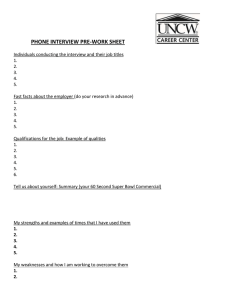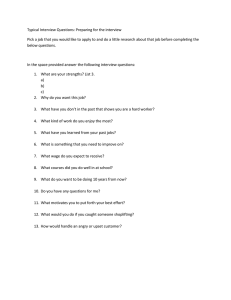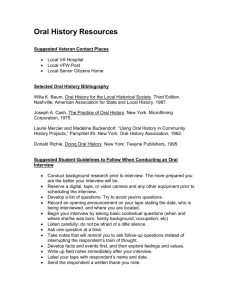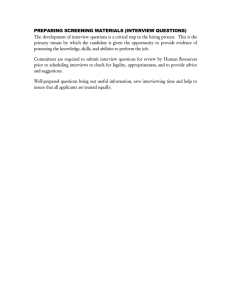How to Interview Discussion Section 4
advertisement
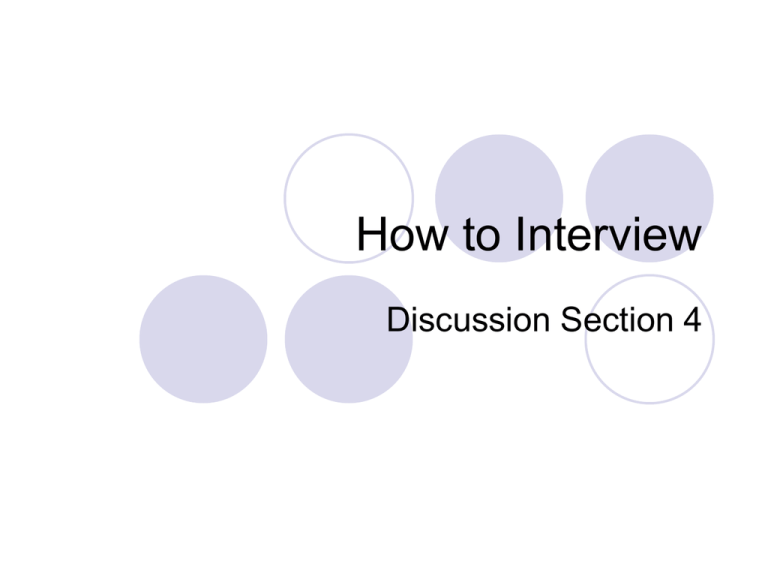
How to Interview Discussion Section 4 Interviews: advantages Quick and easy to conduct Get quick feedback on a range of ideas Can get person’s initial reaction to an idea Can get detailed information from a person Interviews: disadvantages Often takes place away from natural setting The wording of questions or interviewer “body language” can bias answers Recall problems High probability of false positives: user thought something would be an issue but it wasn’t missed problems: user didn’t catch an issue because users may not have a clear idea of how technology will be used Can miss details if question creator does not know what issues to draw out Interviews: minimize disadvantages Type of interview Contextual Inquiry occurs in natural setting Question selection and wording Biasing answers: no leading questions; ask truly open-ended questions Recall, false positives & missed problems: ask user to walk through concrete examples Missed details: pilot interview & revise questions Participant selection False positives & missed problems: talk to several people Interviewing Steps Project goal statement Interview guide: questions, ordering Recruiting participants Conducting the interview Analysis Project Goal Statement What is the goal of the project? “Build an easy-to-use email interface for elderly people with no computer experience.” What do you want to learn from users that will help you accomplish this? Current communication: who, how, frequency (the baseline tasks to support) limitations (the tasks your system can improve) What problems keeps them from using technology now? What would enable them to overcome these problems? Use these to create your interview guide Interview Guide Question wording and ordering After pilot interview, think about project goal & revise by asking how well: your questions, how you asked them, and how the respondent answered helped you learn what you need to accomplish the goal? What could you change to improve your results? Question Wording: 7 rules Ask truly open-ended questions Avoid dichotomous questions Ask singular questions Stay neutral Understand respondent’s language “Why” questions – take care Presupposition questions = good Ask truly open-ended questions Do not presuppose anything about the interviewee’s response, opinion, or feelings Bad = “How satisfied are you with the frequency of your current contact with your grandchildren?” Good = “How do feel about the frequency of your current contact with your grandchildren?” Avoid dichotomous questions Dichotomous: a grammatical structure that suggests a yes or no answer Bad = “Are you satisfied with writing letters?” Good = “How do you feel about writing letters?” Probe: “Why do you feel [insert response].” Ask singular questions No more than one idea should be contained in a single question Bad = “How well do you know and like the your email program?” Good = 1. “How well do you know your email program?” 2. “How do you feel about your email program?” Stay neutral Respondent must be able to tell you anything w/o getting your favor or disfavor Bad = “I’m so glad you answered that way – it makes me feel really good.” Ways to accomplish neutrality: Illustrative examples questions: say you’ve heard it all – good & bad – by listing example answers from others showing you aren’t interested in the sensational, just respondent’s actual experience Illustrative extremes questions: give examples only of extremes No leading questions! Bad = “We’ve been hearing a lot of really positive comments about the program. So what is your assessment?” How does this question lead? Understand respondent’s language Find out the special terms commonly used by people in their setting or among their colleagues to talk about a setting, activities, or other aspects of life Use this language, not other terms “Why” questions – take care “Why” questions are problematic because they… Presuppose things happen for a reason & the respondent knows the reason Require respondents to make analytical & deductive inferences – hard “Why” questions – how to use “Why” can give many types of responses (“Why do you want to learn email?”): programmatic personality information social influence economic outcomes personal motivation philosophical (“Because it takes place at a convenient time.”) (“Because I’m a joiner.”) (“Because a friend told me about it.”) (“Because my priest thought it would be good for me.”) (“Because it was inexpensive.”) (“Because I wanted to learn about the things they’re teaching in the program.”) (“Because God directed me to join.”) (“Because it was there.”) Decide before the interview which of these types is valuable to your goals. Word question to isolate that type Social influence example: “What other people, if any, motivate you to want to learn email?” Presupposition questions = good Assumes respondent has something to say, increasing likelihood that respondent will say something Good = “What is the most important experience you had in the program?” Assumes person has had an important experience Bad = “Have you had any experiences in the program that you would call important?” Dichotomous (yes/no) question Project goal statement Interview guide: questions, ordering Recruiting participants Conducting the interview Analysis Question Ordering Begin with demographic info Age, education, occupation, or other info relevant to your project Some info may logically go first E.g., before asking elderly how they’d like to change their current means of communication, ask what current comm. methods are Ask most important questions first Pick the questions that will give you the most important info and be sure to ask them Narrow down question guide: You may only have time for a few key questions Recruiting Participants Varies based on who users are Usually, get an even mix of male & female Target a demographic to some degree If all participants are drastically different, your results will be drastically different for each: what will you build? Elderly email system: all participants 60+ years, educated, minimal computer literacy, have close family, write letters Project goal statement Interview guide: questions, ordering Recruiting participants Conducting the interview Analysis Conducting the Interview Try to minimize generalization Keep respondent talking about a concrete situation If you hear words like, “we would always…” “I tend to…,” ask for an example Maintain control of the interview Know your goals and what you want to learn Assess the quality of respondent’s comments Direct the conversation appropriately Conducting the Interview Rapport: show respect for respondents so what they say is important because of who is saying it; you will not judge them for the content Give reinforcement or feedback to respondents to let them know the interview is being fulfilled Conducting the Interview Transitions between questions & question prefaces help prevent confusion Probe questions are used to get more in-depth information about a topic who, what, where, when questions asking for more elaboration. Marker: a respondent’s passing reference to an important event or feeling You may not see why it’s important, but respondent thought it important enough to mention Pay attention to “markers” and probe for more info Conducting the Interview Minimize the amount you talk Especially don’t let your opinions affect what the respondent will say Avoid forming a hypothesis & pushing respondent to give you information about it Think about your hypothesis more openly Conducting the Interview Final question: allow respondent to give you information you might not have thought to ask “Anything you care to add?” “What should I have asked you that I didn’t think to ask?” References Patton, M.Q. Qualitative Evaluation and Research Methods. 2nd ed. 1990, Newbury Park, CA: SAGE. Weiss, Robert S. Learning from Strangers: The Art and Method of Qualitative Interview Studies. 1994, New York, NY: The Free Press.


